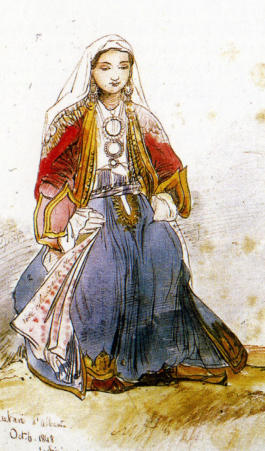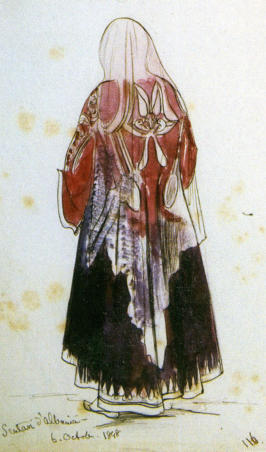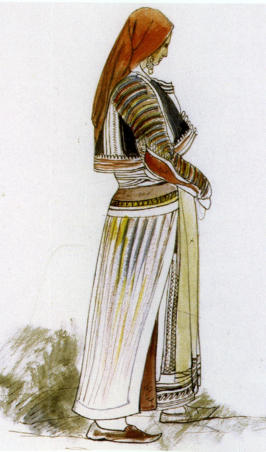| Robert Elsie | AL Art | AL History | AL Language | AL Literature | AL Photography | Contact |

Albania in the Painting of Edward Lear (1848)
Albanien in der Kunst des Malers Edward Lear (1848)
Pikturat shqiptare të Eduard Lirit (Edward Lear, 1848)
EDL017 - Edward Lear: Calliope Bonatti, second daughter of the British vice-consul in Shkodra (Scutari), Albania, posing in native costume, second view, 6 October 1848. “No toilet can be more splendid: purple silk and velvet, elaborately embroidered in gold and silver, form the outer garment, the patterns worked by hand with the greatest taste; two or three undervests covered with embroidery, full purple trousers, innumerable chains of gold and silver coins and medals, with a long white veil, complete the costume, excepting several coloured silk handkerchiefs, which are sewn inside the outer vest, and have a tawdry and ill-arranged look, when compared with the rest of the dress. This gay attire is only worn on great fete days, or on marked occasions, such as marriages and christenings.” Edward Lear in Albania (London 2008), p. 70-71. EDL018 - Edward Lear: Calliope Bonatti, second daughter of the British vice-consul in Shkodra (Scutari), Albania, posing in native costume, third view, 6 October 1848. “The women have their faces covered, so that when out of doors you cannot distinguish Christians from Mohammedans, and one and all dress in scarlet cloaks with square hoods… it is at home that the Skódra lady indulges in a magnificence of costume almost beyond belief.” Edward Lear in Albania (London 2008), p. 67-68. EDL019 - Edward Lear: Woman in Shkodra (Scutari), Albania, in native costume, 6 October 1848. “The novelty of the costumes is striking; for, rich as is the clothing of all these people, the tribes of Ghegheria (a district comprising all the territory north of the river Apsus, generally termed Illyrian Albania, and of which Skódra may be said to be the capital, and Akhridha the most western limit) surpass all their neighbours in gorgeousness of raiment, by adding to their ordinary vestments a long surtout of purple, crimson, or scarlet, trimmed with fur, or bordered with gold thread, or braiding.” Edward Lear in Albania (London 2008), p. 29.
EDL017
EDL018

EDL019





